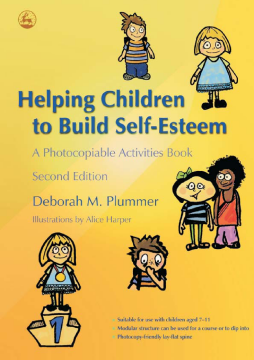
Additional Information
Book Details
Abstract
This second edition of the highly successful Helping Children to Build Self-Esteem is packed with fun and effective activities to help children develop and maintain healthy self-esteem.
New and updated material has been added including a section on running parent groups alongside children's groups, as well as a brand new layout, fresh illustrations, an expanded theoretical section and extra activities.
Based on the author's extensive clinical experience, this activities book will equip and support teaching staff, therapists and carers in encouraging feelings of competence and self-worth in children and their families. It is primarily designed for use with individuals and groups of children aged 7-11, but the ideas can easily be adapted for both older and younger children and children with learning difficulties.
This fully photocopiable resource is invaluable for anyone looking for creative, practical ways of nurturing self-esteem in children.
Praise for the first edition:
'The book is practical and positive. [It] is thoughtfully produced and is evidently grounded in practical experience. It will be useful for professionals working to develop children's self-esteem and confidence.'
Bulletin
This photocopiable book is packed with ideas for activities to boost self-esteem and confidence. Although it is primarily aimed at children aged seven to 11 years old, the ideas are designed to be flexible and easily adapted for children of different ages as well as those with disabilities. The author has tested the activities and some have examples of reactions children had to illustrate their effect.
Children Now
This updated and expanded volume offers activities for use by therapists, teachers, social workers, nurses, and other professionals to encourage self esteem in children aged 7-11.
Book News.com
a rich resource in its own right, or to "pick and mix", incorporating activities into other ways of working, according to the needs of the children and one's own personal and professional preferences.
YoungMinds
This publication should find its way into resource libraries in schools and speech and language therapy departments as well as being generally available to parents and carers.
Afasic News
It contains clear instructions for people working with children to put together a group programme, and whilst Plummer emphasises helping children with speech and language difficulties, it would be easy to adapt the activities to other children.
0-19 Magazine
This practical guide has a fund of ideas describing how teachers can harness powerful young imaginations and help build self-esteem.
The Teacher
The book will be of genuine interest and use for Special Educational Needs coordinators and class teachers alike.
Education 3-13
Deborah M. Plummer is a registered speech and language therapist and imagework practitioner with over 20 years' experience of facilitating groups and working individually with both children and adults. Formerly a clinical lead therapist working within the NHS, she is now a clinical supervisor and lecturer and runs workshops and short courses on the uses of imagery and issues of self-esteem in the UK and abroad. She is the author of Helping Adolescents and Adults to Build Self-Esteem, The Adventures of the Little Tin Tortoise: A Self-esteem Story, Self-Esteem Games for Children and Using Interactive Imagework with Children, all published by Jessica Kingsley Publishers.
This workbook is designed to assist children in moving from head information on self-esteem to heart experiences that [can] impact deeply on their sense of themselves. Deborah Plummer uses imagination and empowerment to move children and adults from discouragement to success. She shows again what people such as Ignatius Loyola and Virginia Satir knew - imagination can be a powerful tool for change.
The Canadian Child and Adolescent Psychiatry Review
Praise for the second edition:
'The layout of the book is well planned. I particularly like:
1. the list of recommended children's books (appendix)
2. the photcopiable activity sheets
3. the guidance on constructive use of the resources when working with children and parents
My favourite chapter was Chapter 2 - "Understanding Self Esteem'"which provided in depth and useful information. I will definitely be making good use of the information and ideas that I read about in this book…I think the book is an excellent resource that teaches ways of helping every child to build self esteem. I recommend it wholeheartedly to parents, childminders and professional childcare providers.'
National Childminding Association
Table of Contents
| Section Title | Page | Action | Price |
|---|---|---|---|
| Prelims [ About the editors| Acknowledgements| Foreword by Robert Chambers] | |||
| PART ONE: Introduction to wellbeing and quality of life: ideas, issues, and choices | |||
| 1 Introduction: why wellbeing? | |||
| 2 Key issues in wellbeing and quality of life assessment | |||
| 3 Practical choices in designing a wellbeing and quality of life assessment | |||
| PART TWO: Wellbeing and quality of life in development practice | |||
| 4 A social justice approach to wellbeing: the PADHI psychosocial framework | |||
| 5 Inner wellbeing: the Wellbeing and Poverty Pathways approach | |||
| 6 Traidcraft: assessing human flourishing | |||
| 7 CAFOD: quality of life Batteries Tool | |||
| 8 Trócaire: measuring change, person wellbeing, and programme impact using the Wheel | |||
| PART THREE: Wellbeing and quality of life in policy and advocacy | |||
| 9 The potential for a wellbeing approach in policy making and sustainable development | |||
| 10 Oxfam’s Humankind Index | |||
| 11 Wellbeing Wales: the Sustainable Wellbeing Framework | |||
| PART FOUR: Going forward | |||
| 12 Conclusion: the politics of working on wellbeing | |||
| Further resources on wellbeing and quality of life | |||
| Index |
